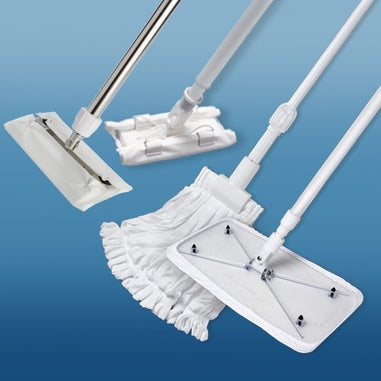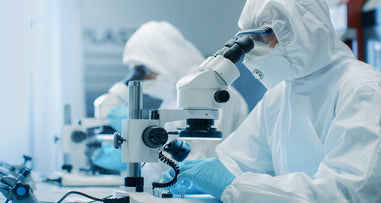- No products in the cart.
Cleanrooms are crucial for manufacturing medical devices, semiconductor devices, compounded pharmaceuticals, solar panels, rechargeable batteries, and much more. A cleanroom is equipped with specialized filtration systems to keep micron-level impurities out of the environment, but that is only part of the equation. Keeping contamination out of a cleanroom depends on every employee who enters, because dust, dander, hair, lint, microbes, skin cells, and spittle are all potential pollutants.
Cleanrooms: Where Meticulous Matters Most
Cleanroom garbing is constructed of lint-free, anti-static material to protect the environment from particles on your skin and streetwear. The order of suiting up with appropriate PPE might vary slightly from facility to facility, but general guidelines follow a similar, disciplined regimen. Site specific SOPs regarding garbing are developed per cleanroom class, USP 797 (sterile compounding) or USP 800 (hazardous drug compounding) gowning guidelines, and/or individual State Board of Pharmacy requirements.

Preparation
Cleanroom level hygiene is just as important for anteroom and gowning areas.
- Do not enter a cleanroom entrance if you are sick or have skin irritation such as sunburn, visible skin flaking, or sores
- It is recommended that you have showered/bathed (no perfume/cologne) and are wearing freshly laundered clothes and undergarments
- Don’t smoke less than 45 minutes before your cleanroom shift
- Do not wear false nails or nail polish and keep nails neatly trimmed
Before entering the main gowning area of a cleanroom:
- Remove coats and sweaters
- Remove all jewelry and personal items
- Remove gum or candy from mouth
- Take a drink water to clear particles from throat
- Remove makeup with cleanroom-approved soap and water
- Wash hands, face, fingernails, and lower arms with cleanroom-approved soap
- Dry with lint-free disposable towels or electronic dryer
- Brush shoes and clean with shoe cleaner
- Depending on your facility, you may need to don a bouffant, beard cover, or surgical mask before entering the main garbing room
- Step on a sticky mat three times
- Put boot covers on over shoes (if required before entering main garbing room)
- Cleanse pre-approved items that you need to take inside, like your badge, with 70% IPA/30% DI water
Procedures
Garbing should proceed stepwise from the dirtiest to the cleanest. When applying PPE, don one cleanroom cover at a time. Take care not to contaminate them on the “dirty” side of bench. A line of demarcation (LOD) can help delineate “clean” versus “dirty.” Perform hand hygiene before gown donning so as not to contaminate your coveralls or gown with splashes from the sink. Cleanroom furnishing, racks, and storage help promote a disciplined approach.
Ensure that gowning and doffing don’t occur simultaneously. Replace PPE if it looks soiled or is damaged. Ensure to wipe down cleanroom bench with a sterile wipe after using. Doffing is performed in the general opposite order of donning.
Entering the Main Gowning Room:
- Put on shoe covers
- Apply cleanroom bouffant
- Before gowning, wash hands thoroughly (USP 797 requires waterless alcohol solution), but do not scrub vigorously with a brush to prevent skin shedding
- Don cleanroom glove liners (if applicable) and rinse with 70% IPA
- Put on cleanroom gloves (these will tuck under coveralls) and rinse with 70% IPA
- Don cleanroom bouffant and beard cover, if necessary
- Affix cleanroom hood, if needed
- Put on facemask/goggles/safety glasses
- Don non-shedding cleanroom coveralls or gown, taking care only to let them touch the “clean” side of the gowning bench and never the floor
- Don cleanroom shoe covers (will overlap coveralls)
- Put on cleanroom gloves and rinse with 70% IPA (will overlap coveralls)
- Inspect self in mirror and/or use buddy system
In the Cleanroom:
- Move slowly to prevent air disturbance
- Clean and inspect tools
- Ensure that you don’t block HEPA filtered air
- Never expose skin inside ISO Class 5 PEC
- IPA-compatible sterile gloves for sterile compounding must be put on in a classified room or segregated compounding room (SCA)
- Dispose of all disposable gowns when leaving cleanroom compounding area
For sterile drug compounding, garbing is conducted in the following order:
- Hair cover, face mask, and beard cover
- Shoe cover
- Hand hygiene
- Non-shedding gown
- Sterile gloves
For sterile hazardous drug compounding, garbing is conducted in the following order:
- Hair cover, face mask, and beard cover
- Double shoe covers
- Hand hygiene
- Non-shedding gown
- Chemotherapy gown
- Two pairs of ASTM Standard 6978-05 compliant gloves
- When removing, do so in the compounding aseptic isolator (C-PEC)
Dress for Success
Cleanroom SOPs are important to develop, update, and practice depending on changing regulatory standards, facility design, and end-use. Ensure that you have all the cleanroom garments you need by stocking up on the essentials with Lab Pro.
PPE
Lab Pro has you covered when it comes to cleanroom apparel and garments. Disposable items for a properly stocked cleanroom include lint-free cleanroom coveralls (bunny suits), isolation gowns, frocks, gloves, bouffant caps, face masks, beard covers, protective sleeves, shoe covers, and boot covers. Reusable items that can be cleaned can include goggles, face shields, helmets, and suits.
Note: Chemicals mentioned in the article are meant to be used for research, industrial work, cleaning or disinfecting and should always be stored out of the reach of young children or infants.
For over 40 years, Lab Pro Inc. has been committed to delivering the highest quality cleanroom apparel and cleaning solutions to medical and biomedical laboratories in California and worldwide. To learn more, visit the biggest Lab Supply showroom in California, or contact us online or












































